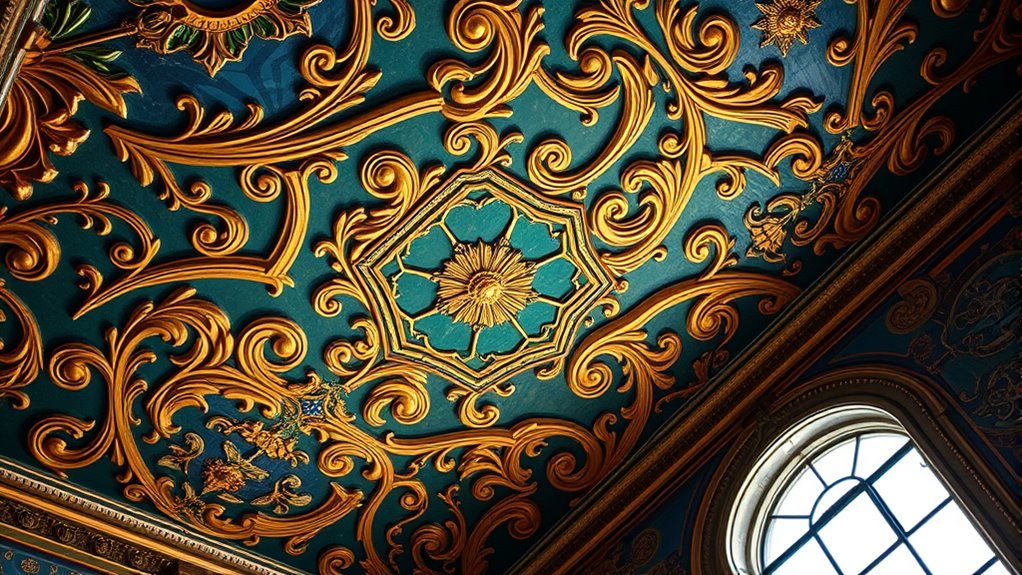Painting the ceiling, the fifth wall, can dramatically change your room’s style and mood. You can choose from smooth or textured finishes, and consider different paint sheens like matte or satin to suit your look. Proper prep, tools, and techniques guarantee a flawless finish that hides imperfections and adds personality. Whether you want subtle elegance or bold patterns, your options influence the space’s overall vibe. If you want to perfect your approach, you’ll find helpful tips to get started below.
Key Takeaways
- Choose the appropriate paint finish (matte or satin) to hide imperfections and create a smooth, cohesive look.
- Prepare the ceiling by cleaning, patching, and taping edges to ensure a clean, even surface before painting.
- Select the right tools—thick-nap roller for textured surfaces and brushes for edges—to achieve professional results.
- Apply multiple thin coats for durability, better coverage, and a seamless, polished appearance.
- Consider ceiling texture and lighting to select colors and finishes that enhance the room’s style and ambiance.

Have you ever wondered how to achieve a smooth, flawless finish when painting ceilings? The key lies in understanding the variety of ceiling textures and paint finishes available, and how each choice influences the final look. Ceiling textures can dramatically alter the character of a room, from a subtle stippled surface to a bold popcorn or swirl pattern. Before you start, consider the existing texture of your ceiling and the effect you want to create. If you’re aiming for a sleek, modern appearance, smooth or lightly textured finishes work best. Conversely, if you prefer a more decorative or forgiving surface, textured ceilings like knockdown or popcorn might suit your style. Knowing the different ceiling textures helps you select the right tools and techniques, guaranteeing a professional-looking result.
When it comes to paint finishes, your options range from matte to high-gloss, each with its own benefits and challenges. Matte finishes are excellent at hiding imperfections and provide a soft, understated look. They’re ideal for ceilings because they don’t reflect much light, creating a consistent, even surface. Eggshell or satin finishes offer a slight sheen that can brighten up the room without being too reflective, making them suitable for ceilings that might have minor flaws. High-gloss or semi-gloss finishes are generally not recommended for ceilings, as their reflective qualities can highlight imperfections and create glare. Selecting the right paint finish depends on the lighting, ceiling texture, and the overall aesthetic you’re after.
Preparation is essential. Begin by cleaning the ceiling thoroughly to remove dust and cobwebs. If the ceiling has an existing textured surface, you might need to lightly sand or patch areas to assure smoothness or to create a better surface for adhesion. Use painter’s tape to protect walls and fixtures, and lay down drop cloths to catch drips. When applying paint, use a roller with a thick nap suited for textured surfaces, or a brush for edges and corners. Applying multiple thin coats ensures better coverage and reduces drips. Don’t forget to work in well-ventilated areas to help paint dry evenly and quickly.
Choosing the right ceiling textures and paint finishes, combined with proper preparation and application techniques, makes a significant difference in how your ceiling looks after painting. It’s not just about covering an old color; it’s about transforming your space with a professional, polished finish. Whether you prefer a smooth, seamless look or a textured, decorative ceiling, understanding these options empowers you to create a ceiling that complements your room’s style and elevates your overall decor.
Frequently Asked Questions
How Do I Choose the Best Ceiling Paint Finish?
You should choose a ceiling paint finish based on your desired look and durability considerations. Matte or flat sheens hide imperfections and create a smooth, non-reflective surface, making them ideal for ceilings. If you need more durability, especially in high-humidity areas, consider an eggshell or satin finish, which offers a slight sheen and easier cleaning. Always match your paint sheen options to your room’s specific needs for the best results.
What Tools Are Essential for Painting Ceilings?
You’ll need a few essential tools for painting ceilings. Start with different brush types, like angled brushes for corners and detail work, and a roller with an extension pole for even coverage. Don’t forget painter’s tape to protect walls and trim. These tools help you achieve a clean, professional finish, making the process smoother and faster. Keep your brushes clean and tape edges carefully for the best results.
How Can I Prevent Drips and Splatters?
Did you know that using proper brush techniques can reduce splatters by up to 50%? To prevent drips and splatters, keep a steady hand and use a high-quality brush designed for ceilings. Always wear protective gear like goggles and cover your furniture and floors with drop cloths. Work in small sections, and avoid overloading your brush with paint. This approach keeps your ceiling painting clean and efficient.
What’s the Drying Time Between Coats?
You should wait about 2 to 4 hours for the drying time between coats, but always check your paint can for specific recoat interval instructions. Keep in mind that factors like humidity and temperature can influence drying times. To guarantee a smooth finish, avoid recoating too soon, as this can cause issues. If unsure, wait until the previous coat is fully dry before applying the next, ensuring the best results.
How Do I Repair Cracks Before Painting?
To repair cracks before painting, start with crack filling using a high-quality filler suitable for your ceiling material. Make certain you remove any loose debris and dust during surface preparation to ensure proper adhesion. Apply the filler smoothly, let it dry completely, and sand it flush with the surface. Proper crack filling and surface preparation prevent future cracks from appearing, giving your ceiling a flawless finish.
Conclusion
So, next time you step back to admire your perfectly painted ceiling, remember—you’ve just conquered the “fifth wall.” Ironically, it’s often the last thing we notice, yet it’s now the first thing everyone looks up at. You’ve turned an overlooked surface into a masterpiece, proving that even the ceiling deserves your attention. Who knew that in painting the ceiling, you’d elevate your entire space—and yourself—just a little higher?










